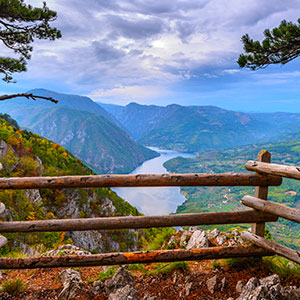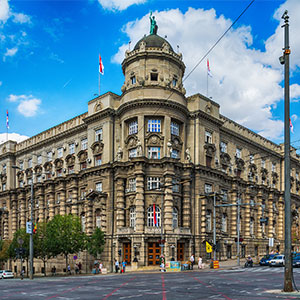- Serbia
Get to know Serbia
- Citizens
Culture and science
Health services
Pension and disability insurance
- Business
Employment
Economy
- Media
- Government
- Contact
Keep in touch
Keepin touch
Whether you have a question, comment, suggestion or any problem in the purview of the government, send us your message and we will try to respond as soon as possible. If your problem is not in our purview, we will forward your message to the relevant institution.
-
 Belgrade, 15 May 2025
Belgrade, 15 May 2025Government passes Air Protection Bill
-
 Belgrade, 15 May 2025
Belgrade, 15 May 2025Expo to serve as catalyst for further accelerated development of Serbia’s economy
-
 Belgrade, 15 May 2025
Belgrade, 15 May 2025Infrastructural connectivity between Serbia, Greece discussed
-
 Belgrade, 15 May 2025
Belgrade, 15 May 2025De-escalation priority topic in dialogue with Priština
-
 Belgrade, 15 May 2025
Belgrade, 15 May 2025Strong German support to modernisation of Serbian energy sector
-
 Belgrade/Brussels, 15 May 2025
Belgrade/Brussels, 15 May 2025Opening of Cluster 3, IBAR in Serbia’s focus
-
 Belgrade, 14 May 2025
Belgrade, 14 May 2025Continuation of fruitful cooperation with Germany’s KfW Development Bank
-
 Belgrade/Abu Dhabi, 14 May 2025
Belgrade/Abu Dhabi, 14 May 2025Strategic partnership, cooperation with UAE in fields of common interest
-
 Belgrade/Abu Dhabi, 14 May 2025
Belgrade/Abu Dhabi, 14 May 2025Serbia, Abu Dhabi agree on cooperation in fight against crime
-
 Belgrade/Luxembourg, 14 May 2025
Belgrade/Luxembourg, 14 May 2025No Council of Europe membership for self-proclaimed “Kosovo”
Opportunities
Serbia the country of opportunities
The information and communication technology (ICT) sector, which recorded a jump in the previous year, represents one of the biggest potentials of Serbia.

Services | Citizens
Citizens come first
Citizens come first
Say goodbye to waiting in queues, crowds at desks and wrong phone numbers. The e-government enables you to handle all administrative matters in a much more convenient manner from your home, office or even on the move, through mobile devices, leaving you with more time for the things that really matter.

Services | Corporate sector
Economy
Economy
The e-government provides many opportunities to companies of all industries and sizes
Highlights
Attractions
Discover Serbia
A combination of traditional and modern makes tourists that visit Serbia come back, while some even decide not to leave at all.
-
Golubac
Golubac is a medieval fortress and cultural monument which was first mentioned in sources from the 14th century. The identity of the builder and the time of construction of this fortress remain a mystery to this day. It is located in the Đerdap National Park, on the banks of the Danube, at the very entrance to the Đerdap Gorge. During past centuries, numerous battles were fought and today it is a significant and popular tourist attraction. The reconstruction of the fortress was completed in 2019.Austrian Development AgencyGolubac -
Kalemegdan
Kalemegdan is a park in Belgrade dating back to the 19th century. Conversion into a park began during the reign of Prince Mihailo Obrenović. The name refers to the plateau around the Belgrade fortress. The name comes from the Turkish words “kale” (fortress) and “mejdan” (battlefield). Kalemegdan houses the Military Museum, the Cvijeta Zuzorić Art Pavilion, the Zoo, the Roman Well, a children's amusement park, Tomb of National Heroes, a large number of sport playgrounds and restaurants and the Natural History Museum.Kalemegdan -
Tara
Tara is a mountain located in western Serbia, bordered on one side by the river Drina, and partly in contact with Zlatibor. Tara is a popular tourist destination, the slopes of which represent one of five national parks in Serbia. It is famous for its hiking trails and the fact that in 1875 Josif Pančić discovered an endemic coniferous tree there, which was named Pančićeva omorika (Serbian spruce) after this famous scientist. One of the biggest attractions in Tara is Drvengrad, a tiny village built by the famous film director Emir Kusturica. Initially, the village served as a filming location, but the construction was continued and it is now a very interesting tourist destination.B. Јоvanović Source: TOSTara -
Viminacium
Viminacium is an archaeological site near Old Kostolac, not far from Požarevac. It is a military camp and city which was active from the 1st to the early 7th century, and for a certain period, it was the capital of the Roman province Moesia Prima. Exploration and excavation were started by Mihailo Valtrović in 1882, and it was continued in the following decades. Since 2012 alone, the following has been discovered: a goddess figure about 4,000 years old, an altar dedicated to nymphs, statues, a necklace and sarcophagi from the Roman period... Explorations are still ongoing, and Viminacium is also home to a scientific-research and visitor centre.D. Bosnić Source: TOSViminacium -
The Šargan Eight
The Šargan Eight is a museum and tourist complex of narrow-gauge railways, which was opened in 1925, and closed in 1974. It is owned by the Serbian Railway Museum. Sections of the former railway line Užice-Višegrad-Sarajevo have been renewed and are used by the museum train “Nostalgia”, in the summer season April-October and winter season 25 December-25 January. The museum railway passes through the natural park of Mokra Gora and Šargan and in one part the Uvac Canyon can be seen.D. Bosnić Source: TOSThe Šargan Eight -
The Saint Sava Church
The Saint Sava Church, located in Vračar in Belgrade, is the largest Serbian Orthodox church as well as the largest Orthodox church in the Balkans. It is built in the place where it is believed that Koca Sinan Pasha burned the relics of Saint Sava, founder of the Serbian Orthodox Church, in 1594. This church is one of the central symbols of Belgrade. It is located in a beautiful park, right next to the National Library, and one can enjoy the church view from the numerous nearby cafés and restaurants.The Saint Sava Church -
The Resava Cave
The Resava Cave, approximately 80 million years old, which is located in the eastern part of Serbia, 20 kilometres from Despotovac, is one of the oldest explored caves in Serbia. Additionally, it is also one of the most beautiful and largest caves in Serbia. Its length is 4,500 metres, of which approximately 2,850 metres is explored, while the part available for tourist tours is about 800 metres long. Almost all types of cave decorations can be found in the cave. Some of them were even given special names due to the shape of cave decoration, such as the Hive or Grandparents. Visitors enjoy seeing this interesting cave. The waterfall Lisine is also found in its vicinity.The Resava Cave -
Gračanica
Gračanica is a 14th-century monastery and an endowment of King Milutin. The monastery is located in the Gračanica village, near Priština, and it is dedicated to the Dormition of the Mother of God. It was restored by the nuns and it has been a convent ever since. The famous fresco of Queen Simonida is located in this monastery, and the Serbian poet Milan Rakić dedicated a poem to her. Gračanica is on UNESCO’s World Heritage List.Gračanica -
Kopaonik
Kopaonik, which is also called the Silver Mountain, is the largest mountain massif in Serbia. One part of Kopaonik is a national park and it is also home to the largest ski centre in the country. The highest peak is the Pančić Peak (2,017 metres), which was named after a physician, botanist and first president of the Serbian Royal Academy, Josif Pančić. Owing to numerous tourist attractions, today Kopaonik is the largest ski centre in Serbia, and due to its rich range of sports and natural beauty, it is one of the most attractive summer destinations for tourists in Serbia.D. Bosnić Source: TOSKopaonik -
The Silver Lake
The Silver Lake is an artificial lake located on the right bank of the Danube, near Veliko Gradište. It is surrounded by hills and is thus cosy and protected, with visitors enjoying the beauty of the landscape. The water in the lake is clear, unpolluted, abundant with fish and suitable for swimming. The lake is a very popular tourist destination both among local and foreign visitors. In recent times, the lake has also been advertised as “Serbian Sea”.The Silver Lake -
Uvac
The Uvac river is a river in Serbia which flows between the mountains of Zlatibor and Zlatar and is part of the Uvac special nature reserve of the 1st category. The canyon is largely inaccessible, and there are numerous monasteries in the village Uvac. The Uvac is the main tributary of the river Lim and one part of it forms a natural border between Serbia and Bosnia and Herzegovina. The Uvac Canyon is home to the largest nesting colony of the griffon vulture in Serbia and one of the largest in the Balkans. This giant eagle, which is the hallmark of this area is also important for Serbia as it is found on its national coat of arms.Uvac -
Dragačevo
Dragačevo is an area in western Serbia, which largely belongs to the municipality of Lučani. Three rivers flow through Dragačevo. The famous Dragačevo Festival is organised in Guča, the annual trumpet festival, which attracts a large number of domestic and foreign tourists. The first festival was organised in 1961 and only four orchestras participated. In the meantime, the festival increased significantly. Today, the festival in Dragačevo, which has only several thousand inhabitants, is annually visited by several hundred thousand visitors from all over the world. The festival is organised in the summer period.D. Bosnić Source: TOSDragačevo -
Gamzigrad
Gamzigrad is an archaeological site near Zaječar, within the ancient Roman imperial place of Felix Romuliana. Gamzigrad was the residence of the Roman emperor Gaius Valeria Maximianus Valerius, which was named Romuliana after his mother. The Palace was never completed, and in the 4th century, the emperors transferred the estate to the Christian church. Since 2007, it has been on UNESCO’s World Heritage List.B. Јоvanović Source: TOSGamzigrad -
Zemun
Zemun, which has been a part of Belgrade since 1934, is located in the southeastern part of Srem, at the confluence of the Sava and Danube rivers. The first inhabitants of Zemun lived in pit houses (zemunice in Serbian), hence the name. The first settlement in the territory of Zemun was Celtic Taurunum, which was located in the place of today's Gardoš and the Zemun Cemetery. The settlement eventually became a fortified and significant port. A Christian fleet arrived from Zemun in the Middle Ages led by John Hunyadi, who helped defend Belgrade from the Turks. After World War II, Zemun was renewed and it became one of the most important municipalities within Belgrade. Today, Zemun is known for its specific architecture, beautiful Danube coast with a promenade and numerous restaurants and cafés.Zemun -
Lepenski Vir
Lepenski Vir is one of the largest and most significant archaeological sites from the Mesolithic and Neolithic age. It is located in the Đerdap Gorge, and it was one of the most important prehistoric cultures, the traces of which are saved in different locations along Đerdap. The explorations in this area were carried out between 1965 and 1970 and were run by professor and archaeologist Dragoslav Srejović. People lived in this area continuously for approximately 2,000 years and turned into an organised community from the original hunters and fruit gatherers.D. Bosnić Source: TOSLepenski Vir -
Žiča
Žiča is a Serbian medieval monastery from the first half of the 12th century, located in the vicinity of Kraljevo. The monastery was founded by Stefan Nemanjić, the first king of the Nemanjić dynasty. At one time, Žiča was the seat of the Serbian Archbishopric, a place where Serbian kings were crowned and bishops appointed. The church is dedicated to the Ascension of Jesus Christ and it is famous for its prominent red facade. In the period from 2006-2008, eight centuries of its existence were marked.B. Jovanović Source: TOSŽiča -
Studenica
Studenica is a Serbian medieval monastery established by Stefan Nemanja in the late 12th century. There are four churches within the walls of the monastery, the most famous ones being the Church of the Virgin and the Church of the King. Along the southern portal of the Church of the Virgin in Studenica, the oldest Serbian clock is placed, sundial, on which the shadow falls on letters, rather than numbers. The monastery is located near modern-day Kraljevo. UNESCO added Studenica to the World Heritage List in 1986.D. Bosnić Source: TOSStudenica -
Manasija
Manasija or Resava is a Serbian medieval monastery from the 15th century, which was founded by Stefan Lazarević. The monastery is near Despotovac. The monastery complex is surrounded by walls that were used for defence. Remains were found in the monastery church which are believed to belong to Despot Stefan. The monastery was restored in the 21st century, and the art found in the monastery, despite being damaged, represents one of the largest achievements of Serbian medieval painting.B. Јоvanović Source: TOSManasija -
The Church of the Resurrection of Jesus
The Church of the Resurrection of Jesus is a catholic church located in Subotica. It was built in 1933 and it was supposed to be a cathedral church, but it remained unfinished to this day, although its interesting architecture continues to attract tourists’ attention. This church is only one of the significant religious buildings in Subotica, where members of different religions have their places of worship. Subotica is an exceptionally beautiful city of special aesthetics and culture that is certainly worth a visit.The Church of the Resurrection of Jesus -
Zlatibor
The Zlatibor Mountain is one of the most popular tourist destinations for Serbian citizens. Zlatibor, which is bordered by the Uvac and Veliki Rzav rivers, is rich in mineral springs, which are believed to have healing powers. There are no natural lakes on Zlatibor, but there are artificial ones, which are tourist attractions. The entire mountain is extremely attractive to tourists, together with its many settlements. The most popular settlement in Zlatibor is the ethno village Sirogojno which contains the most beautiful examples of old authentic houses from this region. In Sirogojno, you can stay in old, but also in modern homes.B. Јоvanović Source: TOSZlatibor -
Kragujevac
Kragujevac is the fourth largest city in Serbia. It is the centre of Šumadija, and it is believed that its name is derived from the name of kraguj bird, which was used for hunting in the past. During World War II, around 3,000 inhabitants were shot, among them 300 students from Kragujevac. The entire area of Šumarice is dedicated to the victims of that shooting and it was turned into a memorial park. Poetess Desanka Maksimović dedicated her “Bloody Tale” to the murdered children from Kragujevac.Kragujevac -
The Vlasina Lake
The Vlasina Lake is located in southeastern Serbia, in the territory of the municipality of Surdulica. The lake was established in the period 1945-1954. It has a large tourist potential that should be further exploited. A number of churches are found around the lake, as well as a monastery in Palja. A bog used to exist in the place of the lake, and the entire Bulgarian cavalry regiment died there during World War I. After this event, a legend spread about a large water monster that lives there and threatens every living thing near the lake. Today, the lake is available to tourists and suitable for swimming.The Vlasina Lake -
The Subotica Synagogue
The Subotica Synagogue is a Jewish place of worship, which was built in Art Nouveau style. The dome of the Church rests on an iron construction supported by eight iron pillars. Facade decorations are based on Hungarian folk motives. After the restoration, the Synagogue was officially opened in 2018.The Subotica Synagogue -
Fruška Gora
Fruška Gora, also known as Alma Mons, is an island mountain in Srem. The largest part of the mountain is in the territory of the Republic of Serbia, while one part is located in Croatia. The mountain was declared a national park in 1960. The highest peak is Red Cot, and probably the most famous one is Stražilovo, where the tomb of the Serbian poet Branko Radičević is located. This mountain is also home to 17 Orthodox monasteries, which were built as pious endowments of Serbian ruling families, after the Great Migration of Serbs. The most famous monasteries are Krušedol, Hopovo, Remeta, Šišatovac and Vrdnik. The most important settlement is the famous Petrovaradin Fortress which is a tourist attraction, as well as the Tower of Vrdnik, which was built in the Roman age, and today it is in ruins. Fruška Gora also has a large number of getaways and resorts, which enable relaxation and enjoyment to their visitors, and numerous wineries, the most famous one being the Kovačević Winery.Fruška Gora -
Đavolja varoš
Đavolja varoš (Devil’s Town) is a natural monument located in southern Serbia, in the territory of the Kuršumlija municipality. The monument is made up of two rare phenomena – clay figures and two sources of highly mineralised water. Clay figures are arranged in two ravines, which are called Devil’s Ravine and Hell’s Ravine. Legend has it that the figures are actually petrified devils who had tortured people for a very long time. After spending the night in front of the Church of Saint Petka, the people would be freed, and demons petrified.D. Bosnić Source: TOSĐavolja varoš -
Đerdap
Đerdap is a national park which is located at the border between Serbia and Romania. The most important part of the national park is the Đerdap Gorge, through which the Danube flows. Đerdap consists of two canyons and three gorges, of which the Golubac Gorge is the most famous one. Archaeological sites confirm that living conditions were always favourable here, and this section houses Lepenski Vir, Dijana, Golubac, remains of the Trajan’s Bridge and the Trajan’s Board. The Iron Gates of the Danube fascinate with beautiful scenery and enchant travellers with a connection to nature and numerous sights. Cruise along the Đerdap Gorge is especially interesting for tourists.Đerdap -
Vinča
The Vinča culture is a young Neolithic and early Neolithic culture from the 5th millennium BC, which appeared when the Starčevo culture in these areas had already begun to end. It includes today’s Serbia, Romania, North Macedonia and Bosnia and Herzegovina. Technologically, this was the most advanced prehistoric culture in the world, and the first metallurgy of copper in Europe appeared in the territory of Serbia. The Vinča Zone was declared an archaeological park. The explorations of the Vinča culture in Serbia began near Aranđelovac in 1901. The attention of the explorers was particularly drawn to the remains of Vinča houses, necropolis, interesting figurines and ceramics that were discovered during excavations.B. Јоvanović Source: TOSVinča -
The Old Mountain
The Old Mountain or Balkan Mountain is located at the border between Serbia and Bulgaria. The highest point of the Old Mountain is the Botev peak (2,376 m). Babin zub (Grandma’s Tooth) is the famous peak on the Old Mountain and an important getaway, near the ascent towards Midžor (2,169 metres), the highest peak of Serbia, excluding Kosovo and Metohija. A part of the massif is protected as a first-category natural park. Approximately 1,200 types of plants are found in this area, of which 115 are endemic, more than 100 protected and strictly protected species and more than 50 species found in the list of endangered flora. The Old Mountain has recently also turned into an attractive family ski centre where you can find good accommodation and modern ski infrastructure.D. Bosnić Source: TOSThe Old Mountain -
Morava
The Morava or the Great Morava is the longest river flowing through Serbia in its entirety, including its tributary the West Morava. The Great Morava is created by the meeting of the South and West Morava at Stalać. By regulation of the river bed, due to frequent flooding, all three rivers are significantly shortened, but the Morava, together with its largest tributary still remains the longest Serbian river (493 km). The Pomoravlje District, the area through which the Great Morava flows, is one of the most fertile regions in Serbia. Historically, the Morava river played a very important role. For example, the country of Prince Lazar in the 14th century was called Moravian Serbia, precisely after the Morava river.D. Bosnić Source: TOSMorava -
Palić
Palić is a town in Serbia within the Subotica municipality. A tram was used for transport in Palić for nearly a century, but it was suspended in 1972, and today visitors arrive in Palić using different means of transport. The Palić Lake’s prominent green colour is due to algae and the fact that it used to be a saline lake, which is used by many people as an argument that the lake represents a remainder of the Pannonian Sea. The mud from the lake is used for medicinal purposes, and this caused Palić to become a spa as early as the mid-19th century. A park and a hotel were later built around the lake, and the place was also popular for building summer houses. There are numerous vineyards on the shores of Palić, with the most famous winery being the Zvonko Bogdan Winery.Palić -
Niš
Niš is the third largest city in Serbia, located in the southeastern part of the country. It is situated on the banks of the Nišava river. In the city of Naissus, which was located in the area of today’s Niš, Roman emperors Constantine the Great and Constantius III were born. The city had a turbulent history and it was conquered or occupied a number of times. The influence of different peoples who lived in this area is clearly reflected in architecture. Some of these peoples include Romans, Byzantines, Ottomans, Austrians, Bulgarians and Germans, who rushed through Niš during the past centuries and left large or small marks on the urban image of the city.Niš -
Novi Sad
Trg Slobode is the main square in Novi Sad, the formation of which began as early as the 18th century. The square is now a pedestrian zone, and the promenade continues on Zmaj Jovina Street. Important buildings in Novi Sad are located here, the most significant of which include the City Hall and the Name of Mary Church, which is known as the Cathedral among inhabitants of this city. A monument to Svetozar Miletić, politician, lawyer and former mayor of Novi Sad is in the central part of the square. The entire square is known as Miletić’s Square among the inhabitants of the city. This square is a typical meeting point, similar to the Prince Mihailo Monument in Belgrade. If you are touring Novi Sad, and you have a local guide, it is likely that you will head towards the Danube Park from Miletić. You will immediately learn to pronounce the name of this park as a real inhabitant of Novi Sad.D. Bosnić Source: TOSNovi Sad -
Rajac
Rajac is a mountainous region, part of the Suvobor mountain, which is located within the Valjevo mountain complex. A number of caves and pits are found in the area of Rajac, and the most important one is Rajac Cave. A number of well-marked mountain trails suitable for hiking are found on the mountain. The photograph shows some of the most famous culinary specialities from this region.D. Bosnić Source: TOSRajac
Contact
Keepin touch
Whether you have a question, comment, suggestion or any problem in the purview of the government, send us your message and we will try to respond as soon as possible. If your problem is not in our purview, we will forward your message to the relevant institution.


































































